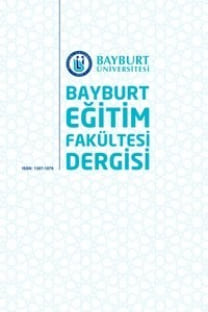Aritmetik İşlemlerinde Öncelik Sırası
The Order of Precedence in Arithmetic Operations
___
- Baki, A. (1994). Breaking with tradition: A stuy of Turkish student teachers’ experiences within a logo-based mathemtical enviroment, Yayınlanmamış doktora Tezi, University of London, London.
- Baki, A. (1998) Matematik öğretiminde işlemsel ve kavramsal bilginin dengelenmesi. Matematik Sempozyumu. Atatürk Üniversitesi.
- Bayazıt, I. Ve Gray, E. (2004). Understanding Inverse Functions: The Relationship between Teaching Practice and Student Learning. In M. J. Honies ve A. B. Fuglestad (Eds.), Proceedings of 28th Conference of the International Group fort he Psychology of Mathematics Educaion (pp. 103-1110). Norway: Bergen University
- DiSessa, A. (1985) Learning about knowning. In Klen, E. (ed). New direction for child development. San Francisco, Jossey-Basic Inc.
- Dönmez, A. (2005). Matematiğin öyküsü ve serüveni. İstanbul: Toplumsal Dönüşüm Yayınları.
- Eisenberg, T. (1991). Function and associated learning difficulties. D. O. Tall (Eds.), Advanced Mathematical Thinking (pp. 140-152). Dordrecht: Kluwer Academic Publishers.
- Garofalo, J & Durant, K. (1991) Where did that come from? A frequent response to mathematics instruction. School Science and Mathematics, 91(17), (pp 318-321)
- Göker, L. (1997) Matematik Tarihi Ve Türk İslam Matematikçilerinin Yeri. İstanbul: Milli Eğitim Basımevi.
- Heibert, J., Carpenter, T.P., Fennema, E., Fuson, K. C., Wearne, D., Murray, H., Oliver, A. & Human, P. (1997). A day in the life of a conceptually based ınsruction classroom.
- Paeke, L. (Eds.), Making sense: teaching and learning mathematics with understanding (pp 101-114). Greenwood: Heinemann
- Karakaş, H. İ. (2001). Matematiğin temelleri sayı sistemleri ve cebirsel yapılar. Ankara, Metu Pres Yayınları.
- Leinhardt, G. (1988). Expertise in ınstructional lessons: an example from fractions. D. A.
- Grouws & T. J. Cooney (Eds.), Perspectives on research on effective mathematics teaching (44-66). Hillsdlae, NJ: Lawrence Erlbaum
- Skemp, R.R. (1987) The psychology of learning mathematics. Hillsdale, NJ: Lawrance Erlbaum Associates.
- ISSN: 1307-1076
- Yayın Aralığı: 4
- Başlangıç: 2006
- Yayıncı: BAYBURT UNIVERSITESI
Quality In Preschool Education: The Views of Teachers and Assistant Teachers
Abdulhamit KARADEMİR, Mehmet Akif CİNGİ, Fatih DERELİ, Berrin AKMAN
İlkokuma Yazma Öğretimi Dersinde Mikro Öğretim Uygulaması Örneği
Sevil FİLİZ, Cananece BÜYÜKKAYA, Tuba TURAN ÖZÇELİK
Ortaokullarda Uygulanan Destekleme ve Yetiştirme Kurslarına Dair Öğrenci Görüşleri
Abdulkadir TUNA, Abdullah Çağrı BİBER, Ahmet Cem POLAT, Fatih ALTINOK, Uğur KÜÇÜKOĞLU
Abdullah KAPLAN, Muhammet DORUK, Mesut ÖZTÜRK
Okul Öncesi Eğitimde Kalite: Öğretmen ve Yardımcı Öğretmen Görüşleri
Abdulhamit KARADEMİR, Mehmet Akif CİNGİ, Fatih DERELİ, Berrin AKMAN
Ortaokul 5. Sınıf Öğrencilerinin Hoşgörü Eğilimlerinin Çeşitli Değişkenler Açısından İncelenmesi
Zeynep Tuba Kalın, Ahmet Nalçacı
2015 Hayat Bilgisi Öğretim Programının Sosyal Beceriler Bağlamında İncelenmesi
